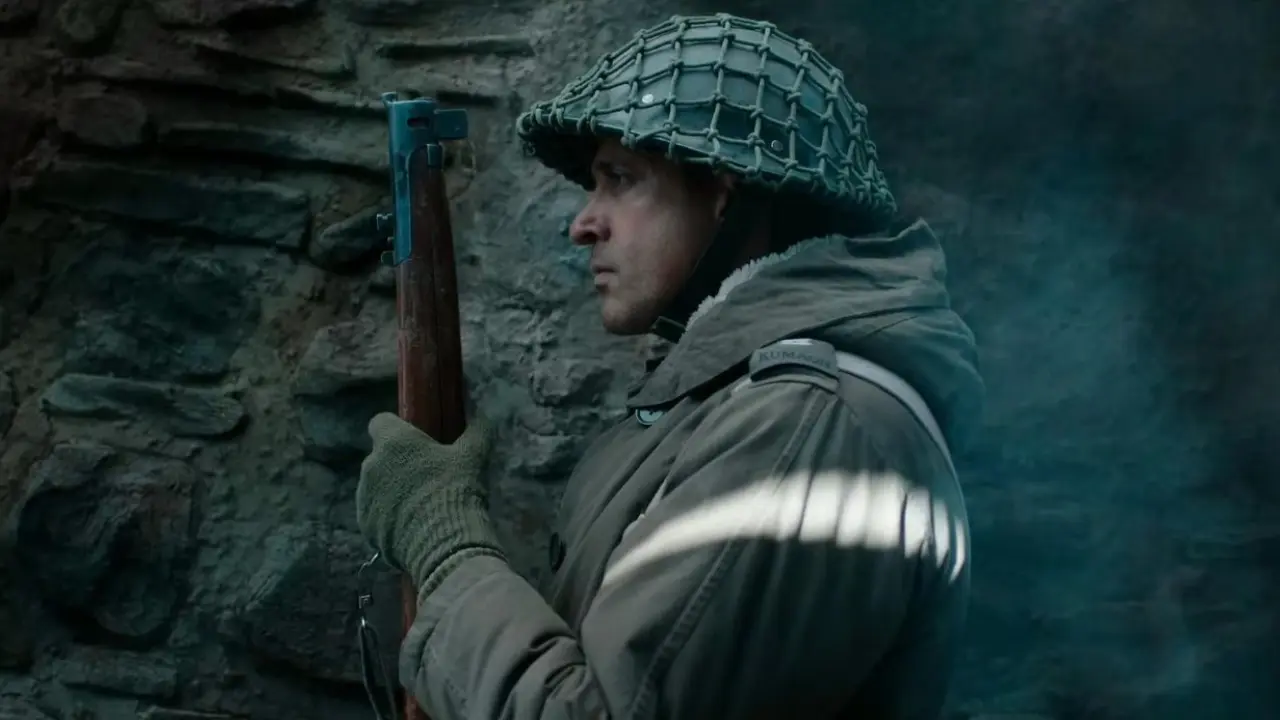
Director: Razneesh Ghai
Actors: Farhan Akhtar, Sparsh Walia
Rating: 4/5
The protagonist of this picture,leading the eponymous 120 Bahadur, is Major Shaitan Singh. That name obviously strikes a thought in the viewer. As it does with the jawans he’s leading, in the Indo-China war, that this film is set in.
The soldiers round up around their boss, in a scene, guessing the etymology.
In the sense of why would parents name their new-born Shaitan/Devil, after all! The guess work includes the fact that he must’ve been a naughty infant, or that a teacher actually named him so, etc.
The hero still doesn’t tell you why he’s named Shaitan. The scene is left as is. The curiosity continues. Which is just the way as it should be, rather than movies that explain everything.
This one, in fact, hardly burdens you with detailed context/backdrop to the Indo-China relations/war itself, besides an opening narration by Amitabh Bachchan, with stock footage of Prime Minister Jawaharlal Nehru, suggesting that there was an expressed friendship between the two neighbouring nations once, followed by fatal betrayal.
India, indeed, lost the expansionist 1962 China war. 120 Bahadur is about a battle that she did win, while heavily outnumbered against an estimated 3000 Chinese soldiers, at a particular post, in Ladakh. Who were these 120 Bahadurs?
As you can see, they belonged to the Ahir community, from the plains, unused to sub-zero temperatures, and the harshly Himalayan terrain. This is widely known/celebrated as the Battle of Rezang La of November 18, 1962.
It’s preserved in public memory enough that I find myself extensively ChatGPT/Googling, as would you— on both the pastoral Ahir community, that ascribes its lineage to the legend of Lord Krishna, and the battle they fought as Charlie Company under 13 Kumaon Regiment.
That’s what great movies do. Including war films, whether that be Dunkirk (on WWII), or Platoon (for Vietnam War). They ignite supreme interest. 120 Bahadur is not an exception.
Farhan Akhtar plays the said Major Shaitan Singh. He also made Lakshya (2004) on the 1999 Indo-Pak Kargil War, similarly shot in Ladakh. He was the director then. He’s the lead actor now, and has been a multi-hyphenate since, including an onstage rockstar.
What you find inspiring about him as a performer, regardless, is how he confidently employs his uniqueness, whether that be the husk in his voice, or understated mannerisms, to own his talent, and simply put it out the best he can. Working his way around, without overthinking the reception.
You can tell that at least, he’s engrossed. You’re drawn to Major Shaitan Singh, to whatever extent as an audience, because he’s feeling the role. You sense it. He’s had a decent run as an actor, hence.
Except for certain films, especially those not produced by him, the likes of Lucknow Central (2017), where he looks lost as a result. 120 Bahadur is by itself a remarkable production — tightly edited, handpicked ensemble cast, firstrate sound design, the works — by his own company, i.e. Excel (along with producer Amit Chandrra).
This is essential for a movie of this genre, since it’s all about the execution, isn’t it?
The idea is already known. Take Lakshya. It means goal. In the very first shot, you watch the lead, Hrithik Roshan, in the Army now, so that goal has been visibly accomplished.
Likewise, 120 Bahadur opens with a wounded radio-operator (Sparsh Walia) — you’re sure, so ahead of time that he’s the sole survivor — narrating the story of C-Company at Rezang La.
What happens next, hence, is not the point. How it happens is wholly where the magic resides.
Also, as anybody on Instagram will tell you, point the camera anywhere in the picturesque Ladakh, the images speak to you, anyway. What they tell becomes crucial, in this case.
In that vein, while the soldiers are on a war-path, the battle is viewed from one side alone, the script steers clear of bombastic delulu for self-pride/patriotism. You can equally gauge the price of war, protecting the “sar zameen” (top plot of the national map).
More so, an intense hate for the other — that professional armies rarely indulge in — is not the emotion you emerge from the theatre with.
Maybe, wishing to join the Army, as kids who watched Lakshya did, or Vishnuvardhan’s underrated Shershaah (2021); or to be with the Air Force, as for those from an earlier vintage, who loved Govind Nihalani’s Vijeta (1982)?
Yup. That’s still a positive sentiment.
Speaking of past films, there are two I did watch, as homework for 120 Bahadur, if you may. And this is way better than both, although comparisons are absolutely unnecessary.
The first being Chetan Anand’s Haqeeqat (1964), with multiple Majors, Captain, Brigadier, and soldiers, along with local romance, that provided a broader overview of the 1962 Sino-Indian War.
It beats me, still, how the top actors (Dharmendra, Balraj Sahni, etal), along with Anand and his crew, pulled off that wide-angled war film, in the inhospitable Ladakh, back in the early ’60s!
The other picture, I speedwatched? Dhaakad (2022), which is Razneesh Ghai, the 120 Bahadur director’s debut. Now Dhaakad, to be fair, is snazzy looking, but silly, tone-deaf, and dumb.
But it’s a proper mainstream,mad-actioner, which would’ve probably landed Ghai, besides the script (Rajiv G Menon), this job.
By now, we’ve got as close to watching war as a lived experience as Sam Mendes’s 1917 (2019), that it’s impossible to turn back from it. Also, if you recall, actual/YouTube footage of Indian and Chinese soldiers, at it, with their elbows, legs and fists, in Galwan Valley (June, 2020).
Given all that, the last 20-30 minutes of 120 Bahadur (and I should’ve clocked it), involving shelling, machine-guns, hand-to-hand combat, and the sheer mania of the moments, that grip and jolt you, simultaneously, remain the most engagingly realistic, live-action scenes of war, that I’ve watched in a Hindi film. And I mean, ever!







